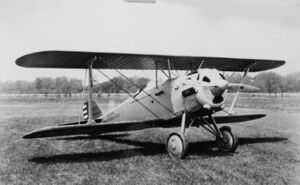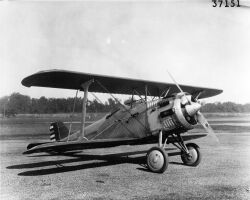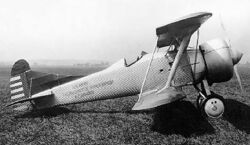Engineering:Thomas-Morse XP-13 Viper
| XP-13 | |
|---|---|

| |
| Thomas-Morse XP-13 | |
| Role | Fighter |
| Manufacturer | Thomas-Morse |
| Designer | B. Douglas Thomas[1] |
| Introduction | June 1929 |
| Primary user | United States Army Air Service |
| Number built | 1[2] |
The XP-13 Viper was a prototype biplane fighter aircraft designed by the United States company Thomas-Morse Aircraft Corporation. The airplane was delivered to the United States Army in 1929, but they did not adopt it.
Design and development
This aircraft was one of several B. Douglas Thomas designs built in hopes of a production contract from the Army, following the successful Thomas-Morse MB-3 of 1919. Financed by the company, and named the "Viper", it was officially purchased by the Army in June 1929 and designated "XP-13".
The XP-13 fuselage had a corrugated aluminum skin built over a metal frame; the flying surfaces were also metal-framed, but covered with the traditional fabric. While designed to use the 600 hp Curtiss H-1640-1 Chieftain engine, (a novel 12-cylinder two-row air-cooled radial with the rear cylinders directly behind the front cylinders rather than staggered as normal in a two-row radial[3]) for which the XP-13 incorporated a complex system of baffles to direct cooling air over the engine, the engine simply would not stay cool enough, and in September 1930 it was replaced with a Pratt & Whitney SR1340C Wasp of 450 hp. Ironically, the lower-power engine actually resulted in a speed increase of 15 mph, at least partly because of the weight savings.[4]
In the end, the Army decided against production, Thomas-Morse was acquired by Consolidated Aircraft, and the prototype was lost to an inflight fire.
Variants
- XP-13
- Prototype, serial number 29-453 with 600 hp (448 kW) Curtiss H-1640-1 Chieftain hex engine[2]
- XP-13A
- The XP-13 modified with a 525 hp (391 kW) Pratt & Whitney SR-1340-C enclosed in a NACA cowling, along with a revised fin and rudder[5]
- XP-14
- This designation was used for a proposed Curtiss version of the Viper with the Curtiss H-1640-1 Chieftain hex engine
Operators
 United States
United States
- United States Army Air Service
Specifications (XP-13 (Chieftain engine))
Data from William Green; Gordon Swanborough (1994). The Complete Book of Fighters: An Illustrated Encyclopedia of Every Fighter Aircraft Built and Flown. Salamander. ISBN 978-0-86101-643-3. https://books.google.com/books?id=zVeXAAAACAAJ.
General characteristics
- Crew: 1
- Length: 23 ft 6 in (7.16 m)
- Wingspan: 28 ft 0 in (8.53 m)
- Height: 8 ft 5 in (2.56 m)
- Wing area: 189 sq ft (17.6 m2)
- Empty weight: 2,262 lb (1,026 kg)
- Gross weight: 3,256 lb (1,477 kg)
- Powerplant: 1 × Curtiss H-1640-1 Chieftain 12-cyliner two-row air-cooled radial engine, 600 hp (448 kW)
Performance
- Maximum speed: 150 kn (172 mph, 277 km/h) (at sea level)
- Cruise speed: 113 kn (130 mph, 209 km/h) [6]
- Range: 168 nmi (193 mi, 312 km) [6]
- Service ceiling: 20,775 ft (6,300 m)
- Rate of climb: 1,700 ft/min (8.6 m/s) [6]
Armament
none
See also
Related lists
- List of fighter aircraft
- List of military aircraft of the United States
References
- Notes
- ↑ The Complete Book of Fighters Editors: William Green & Gordon Swanborough (Barnes & Noble Books New York, 1998, ISBN:0-7607-0904-1)
- ↑ 2.0 2.1 "U.S. Army Aircraft 1908–1946" by James C. Fahey, 1946, 64pp.
- ↑ Gunston 1986, p.46.
- ↑ "U.S. Fighters", by Lloyd S. Jones, (Aero Publishers, Inc. ISBN:0-8168-9200-8, 1975) pp. 46–47
- ↑ "The American Fighter", Enzo Angellucci and Peter Bowers, (Orion Books ISBN:0-517-56588-9), 1987
- ↑ 6.0 6.1 6.2 Dorr and Donald 1990, p.43
- Bibliography
- Dorr, Robert F. and David Donald. Fighters of the United States Air Force. London:Temple, 1990. ISBN:0-600-55094-X.
- Gunston, Bill, World Encyclopedia of Aero Engines. London: Guild Publishing, 1986.
External links
 |



